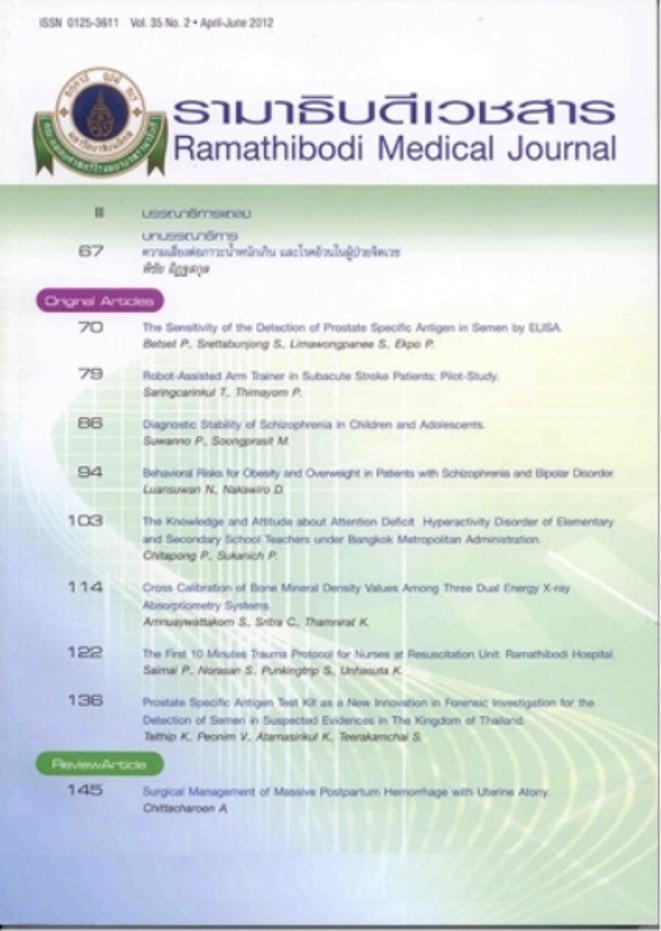Diagnostic Stability of Schizophrenia in Children and Adolescents
Keywords:
Schizophrenia, Diagnostic stability, Children, AdolescentsAbstract
Objective: To examine diagnostic stability of schizophrenia in children and adolescents and to determine factor associated with diagnostic stability.
Methods: This was a retrospective chart review of patients who were diagnosed schizophrenia when they were below 18 years old. All subjects, both inpatients and outpatient, received psychiatric care at Ramathibodi Hospital during January 1999 to December 2009.
Results: There were 40 subjects who received the diagnosis during 11-17 years of age (mean 14.88 years) and the follow-up time was 4.18 ± 2.15 (mean ± S.D.). After receiving the diagnosis of schizophrenia, 36 from 40 subjects (90%) were finally diagnosed schizophrenia, whereas 4 subjects’ diagnosis (10%) were changed to other psychiatric disorders which the diagnosis were bipolar disorder, major depressive disorder with psychotic feature, psychotic disorder-NOS and autism. The median time to change diagnosis was 1.58 years. Factor associated with diagnosis stability was comorbidity.
Conclusion: Among children and adolescents, after receiving the diagnosis of schizophrenia, approximately 10% of patient had diagnosis changes to other psychiatric disorders and factor associated with diagnosis stability was comorbidity.
References
Gogtay N. Childhood Onset Schizophrenia and Early Onset Schizophrenia spectrum disorders. In: Martin A, Volkmar FR, eds. Lewis's Child and Adolescent Psychiatry: A Comprehensive Textbook. 4th ed. Philadelphia: Lippincott Williams & Wilkins; 2007:493-503.
Hollis C. Schizophrenia and Allied Disorders. In: Rutter M, Bishop DVM, Pine DS, Scott S, Stevenson J, Taylor E, Thapar A, eds. Rutter’s Child and Adolescent Psychiatry. 5th ed. Oxford, UK: Blackwell Publishing Ltd; 2008:737-58. https://onlinelibrary.wiley.com/doi/pdf/10.1002/9781444300895.
Schimmelmann BG, Conus P, Edwards J, McGorry PD, Lambert M. Diagnostic stability 18 months after treatment initiation for first-episode psychosis. J Clin Psychiatry. 2005;66(10):1239-46.
Jarbin H, von Knorring AL. Diagnostic stability in adolescent onset psychotic disorders. Eur Child Adolesc Psychiatry. 2003;12(1):15-22. doi:10.1007/s00787-003-0300-z.
Hollis C. Adult outcomes of child- and adolescent-onset schizophrenia: diagnostic stability and predictive validity. Am J Psychiatry. 2000;157(10):1652-9. doi:10.1176/appi.ajp.157.10.1652.
Fraguas D, de Castro MJ, Medina O, Parellada M, Moreno D, Graell M, et al. Does diagnostic classification of early-onset psychosis change over follow-up? Child Psychiatry Hum Dev. 2008;39(2):137-45. doi:10.1007/s10578-007-0076-3.













